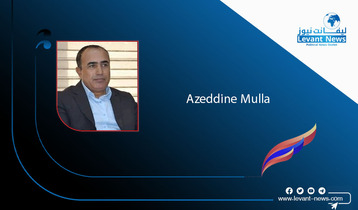-
The Yazidi genocide, eight years on, remains unaddressed

In the northern Nineveh province of Iraq, there resided a small community known as the Yazidis.
Estimates put the global number of Yazidis at roughly 800, 000 people with the vast majority living in northern Iraq.
The main living areas of Yazidis include the Sinjar mountain range, and the Sheikhan region around the city of 'Ain Sifni, as well as the twin cities of Bahzani and Ba'shiqa near Mosul.
The Yazidis are an ethno -religious minority whose existence as a sect is engulfed by mystery. The city of Sinjar huddled at the base of the southeastern side of Mount Sinjar forms the region's heart. Much of Sinjar was destroyed either by the Islamic State (ISIS) or in the battle for liberation.
Following the uproar in the Middle East of 2011, an Islamic fundamentalist militant group called the Islamic State of Syria and Iraq, declared an Islamic Caliphate in Syria and Iraq.
In June 2014, IS militants captured the center of the Nineveh governorate in Iraq and embarked on a campaign of purifying the Caliphate of non-Arabs and non-Sunni Muslims. In the same month, hundreds of ISIS fighters approached Sinjar intending to capture all the Yazidi villages, towns, and the city of Sinjar. Ninety per cent of the Yazidi areas lay within the disputed areas.
However, early on August 3, 2014, fighters of the Islamic State (IS) went on a genocidal rampage against the Iraqi Yazid minority in Sinjar.
From Ba'aj in the southwest, Tal Afar and Mosul in the east, and from Tal Hamis and Shadadi in Syria in the west, IS militants converged on Sinjar.
By the time, all 350,000 people living in Sinjar had left their homes, nearly 50,000 people sought refuge on the dry and desolate Mount Sinjar.
It was the Iraq dictator Saddam Husain that in 1970s razed the traditional Yazidi habitat on the mountain and beneath enforcing Yazidis to be relocate in vulnerable urban villages constructed for the end and known as compounds.
Villages on the plain had the lion's share in the barbarities committed. The attack began at 2:10 after midnight, however, resistance at the two southern villages of Gir Zerik and Siba Sheikh Khidir gave time to people in the whole area to ascend Mount Sinjar.
At dawn, the line of resistance was pierced. By then thousands of people had fled their homes. However, thousands others were left stuck on the roads.
Mount Sinjar, a ragged 1 mile-high and 60 mile -long arid ridge identified in local mythology as the final resting place of Noah's ark, was the destination. Those made it to the mountain were faced with a harsh reality. With no access to water or food, thousands of infants and the elderly lost their lives under scorching heat of summer. Many others returned home and eventually were captured.
On 6 August, IS announced it controlled Sinjar proper and on 7 August American, British, French and Australian planes began to airdrop humanitarian aid to those trapped on the mountain.
In the first days of the genocide, 1,293 people were killed and over 6,000 people were abducted, according to the Kurdistan Regional Government (KRG) Office for Rescuing Kidnapped Yazidis.
Due to their ethnicity and religion, Yazidis were among the most severely affected communities. The Sinjar attack marked the start of a highly systematized and brutal campaign to erase the Yazidi culture. The Islamic States used selective sayings and traditions of Prophet Muhammad and his companions depending of their strict interpretation of Islam and its defunct corpus.
The centuries old religion is shrouded in mystery. However, a Yazidi hypothesis suggests that the Yazidism is very old.
The sect, however, is a non-missionary religion in which neither new believers are welcome nor renegades are permitted, their admittance is impossible.
Today, after eight years of family loss and bereavement the Yazidi community is shattered. As the plight of the IS victims- mostly women- trails, the perpetrators of the genocide are at large.
With western governments grapple with the thorny issue of how to deal with their citizens currently held in Syria and Iraq, many of them have returned to their countries of origin undetected or without being prosecuted or charge.
The world had done little to address the plight of the Yazidi people of Iraq. Some 2,863 still remain missing. Many of those who are missing are believed to be in the refugee /IDP al-Hol Camp in Syria. Those returned face difficulties in reintegrating anew into their own community. Hundreds of others were relocated to third countries. Much psychological support is needed.
The vast majority still lives in internally displaced persons camps in northern Iraq that lack basic everyday life needs.
On October 9, 2020, the Sinjar agreement was announced. However, up to date, it remains ink on paper.
In March 2021, after nearly two years of deliberations, the Yazidi Female Survivors Law was passed by the Iraqi Parliament. The law (Law No. 8 of 2021) applies to ''every woman Yazidi survivor who was kidnapped by ISIS and later liberated, in addition to women and girls from the Turkmen, Christian and Shabak components who were subjected to the same crimes mentioned'' reads the legislation.
As perpetrators of the genocide are at large, justice should be served. In late 2021, Taha al-Jumailly, an Iraqi citizen, was found guilty of genocide and war crimes resulting in death at the court in Frankfurt. The verdict passed by the Frankfurt court gave a glimpse of hope to the survivors of the genocide. However, the process is a very slow one.
Earlier in the year, Jennifer Wenisch, Taha's German wife, was sentenced in a separate trial to 10 years in prison in connection with the killing. Prosecuting al-Jumailly on foreign soil is based on the universal principle of justice.
Today, much of the Yazidi ancestral homelands lay in ruins, villages that lack basic services and infrastructure are deserted. Unexploded mines planted by IS fighters, the smell of unburied bodies, among others, are all hurdles to the return of the Yazidi people to their ancestral homelands.
Few have returned others refrain to return as the security situation in the mountains and nearby areas remain unsettled.
As Sinjar has turned into a battleground for state, and non-state forces the plight of Yazidis proceeds unabatedly.
BY: Lazghine Ya'qoube
You May Also Like
Popular Posts
Caricature
BENEFIT Sponsors BuildHer...
- April 23, 2025
BENEFIT, the Kingdom’s innovator and leading company in Fintech and electronic financial transactions service, has sponsored the BuildHer CityHack 2025 Hackathon, a two-day event spearheaded by the College of Engineering and Technology at the Royal University for Women (RUW).
Aimed at secondary school students, the event brought together a distinguished group of academic professionals and technology experts to mentor and inspire young participants.
More than 100 high school students from across the Kingdom of Bahrain took part in the hackathon, which featured an intensive programme of training workshops and hands-on sessions. These activities were tailored to enhance participants’ critical thinking, collaborative problem-solving, and team-building capabilities, while also encouraging the development of practical and sustainable solutions to contemporary challenges using modern technological tools.
BENEFIT’s Chief Executive Mr. Abdulwahed AlJanahi, commented: “Our support for this educational hackathon reflects our long-term strategic vision to nurture the talents of emerging national youth and empower the next generation of accomplished female leaders in technology. By fostering creativity and innovation, we aim to contribute meaningfully to Bahrain’s comprehensive development goals and align with the aspirations outlined in the Kingdom’s Vision 2030—an ambition in which BENEFIT plays a central role.”
Professor Riyadh Yousif Hamzah, President of the Royal University for Women, commented: “This initiative reflects our commitment to advancing women in STEM fields. We're cultivating a generation of creative, solution-driven female leaders who will drive national development. Our partnership with BENEFIT exemplifies the powerful synergy between academia and private sector in supporting educational innovation.”
Hanan Abdulla Hasan, Senior Manager, PR & Communication at BENEFIT, said: “We are honoured to collaborate with RUW in supporting this remarkable technology-focused event. It highlights our commitment to social responsibility, and our ongoing efforts to enhance the digital and innovation capabilities of young Bahraini women and foster their ability to harness technological tools in the service of a smarter, more sustainable future.”
For his part, Dr. Humam ElAgha, Acting Dean of the College of Engineering and Technology at the University, said: “BuildHer CityHack 2025 embodies our hands-on approach to education. By tackling real-world problems through creative thinking and sustainable solutions, we're preparing women to thrive in the knowledge economy – a cornerstone of the University's vision.”
opinion
Report
ads
Newsletter
Subscribe to our mailing list to get the new updates!






















